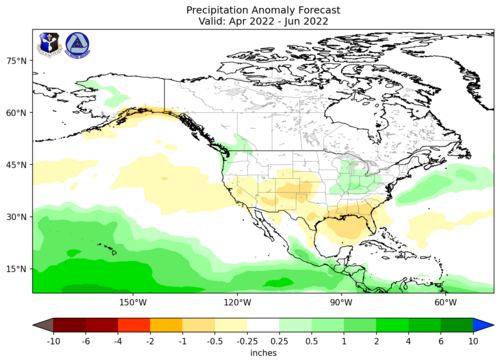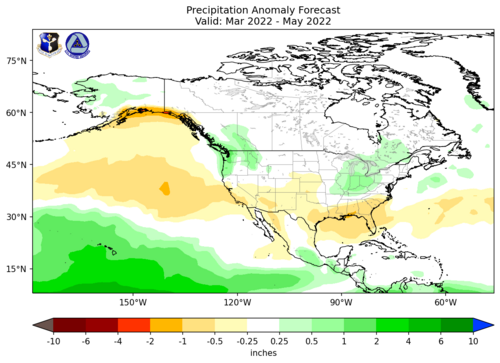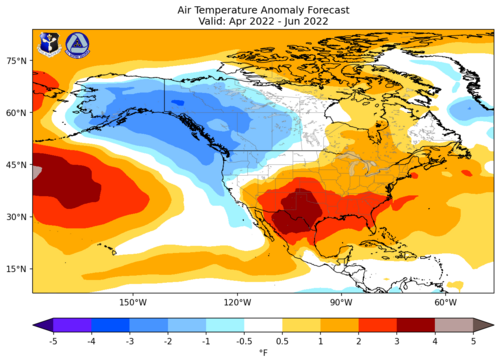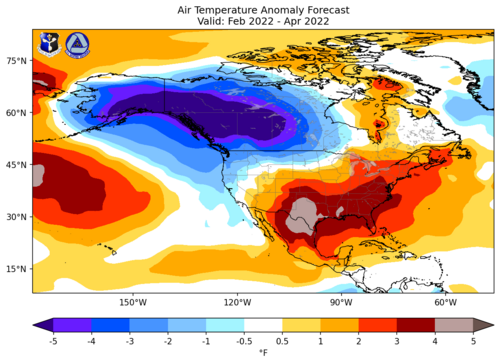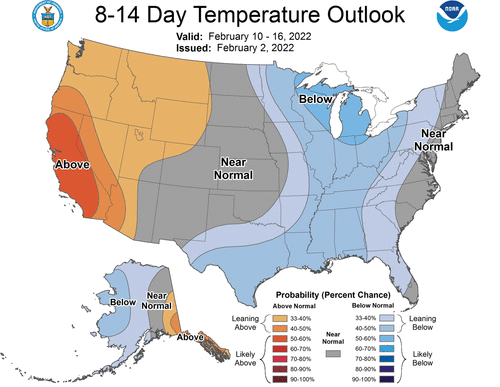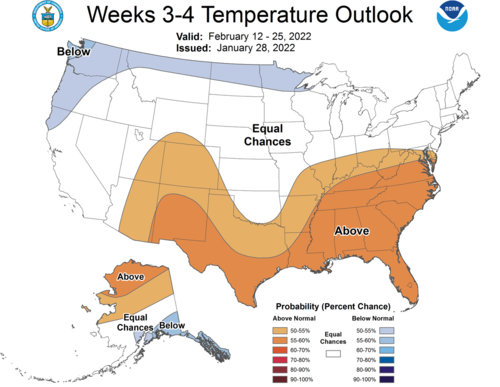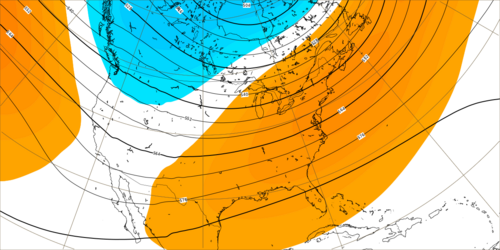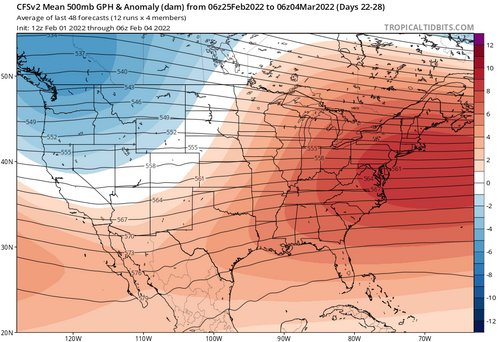adlyons
EF2
Hey everybody, I figured id get the ball rolling with the 2022 State of the Chase Season thread given we are now at 2 weeks since the new year. Hoping to see a repeat of last years awesome discussion with a few seasonal forecasts thrown in! I wanted to touch on some verification for my seasonal forecast last year. Here is my post from March 1st last year.
Well, happy spring everyone! It being the start of traditional chase season I feel confident enough to lock in a forecast.
Forecast 20201 Tornado Season (MAMJ) :
Counts: Average (754 tornadoes across the CONUS during spring, 1250 plus or minus 50 for the year)
I feel fairly confident on average numbers for the chase season and year. With a moderate La Nina, but complicating factors such as drought, I think we see pretty normal activity. This activity should pick up fairly quickly here over the next two weeks with the first hints of the spring pattern shaping up. Some killers for this would be an early northward retreat of the jet (Aka Death Ridge) cutting into numbers early. This is a distinct possibility given the ongoing drought. A second, perhaps better for us failure mode would be a weak resurgent la nina. This could throw out some higher tornado numbers, though I think this is less likely. Its about 50/50 which side of the coin we end up on, which means I'm going to hedge to average.
Outbreak Days (10+ Tornadoes within 6 hours): Above Average
Its an emerging trend, fewer tornado days, but more tornadoes per day. Im sticking with that. You can define outbreaks in many ways so I'll have to run some stats to verify, but I think we see a more active outbreak pattern going into April and a few very big count days. The forecast is also calling for an above-normal hurricane year. I think we see another active TC tornado year this summer and fall.
Number of EF2+ tornadoes: Well Above Average (Greater than 1 STD above the normal mean)
Im taking a bit of a risk on this one but, with the southeast and eastern half (more populated) of tornado Alley looking more favorable, I'm leaning towards a much higher count of sig tors for the simple fact I expect more of them to hit things. The same trend will probably hold for fatalities.
Chasabillity Score: Average 6/10
My completely scientific and no non-sense chasing index, just kidding it's entirely arbitrary. Not a great year, not a bad year, somewhere right in the middle with a bit more chasing potential. We probably won't be chasing west of I-35 as much as we would like putting a dent into the chaseabillity of some systems, but the average counts combined with a few bigger days will get peoples chasing counts up. Midwestern gang and the southeast should have a decent year. Southern and central plains also won't have much to complain about. Perhaps not the best for the front range and Texas Panhandle guys and gals but a few days spark off. A banner year for a few, but sufficient for most.
We will see where we go from here. Good luck to everyone, stay safe and happy hunting!
A couple of points. Overall my yearly number prediction was pretty darn close. I predicted just below average on the annual inflation adjusted count and was darn close with the year end reports falling just 30 shy of my bottom end (1250 plus or minus 50). My big miss was the fact that April was very quiet and October and December ended up saving the average!
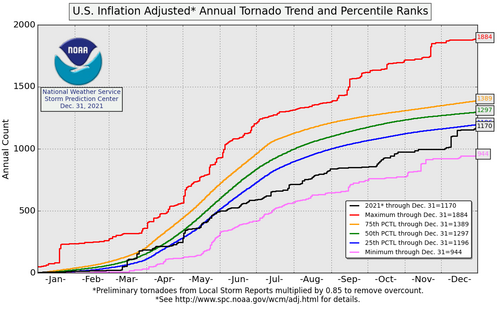
As for my spring count estimate (754), I fell a bit short with only 703 tornadoes being recorded between March and June. As mentioned, April was unusually slow this year with only 73 reported tornadoes. But again, not terrible with how things ended up.
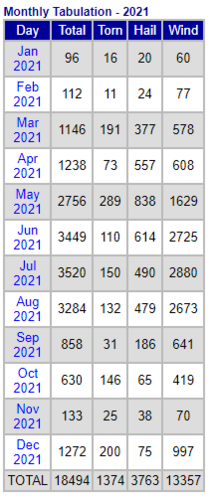
Moving on to the outbreak Days, I'm still working on some verification metrics for this. It appears as though there were much fewer outbreak days but the few outbreaks we did have were sizeable. This is a known trend with tornadoes as of late and something I need to look at further. For now I'm going to assign a fail to this part of the forecast as I suggested things would be more active than they appeared to be. And several key outbreaks occurred well into the cool season outside of the time range I was really shooting for. I did make explicitly mention for the threat for several outbreaks associated with land falling TCs, this appears to have gone well with several big days happening across the Mid Atlantic.
Now to EF2+ tornadoes, Again, still working on some verification metrics for the counts of EF2+ but subjective interpretation says I did okay in this regard. The big outbreak days we did have produced quite a few sig tors. We also had the most fatalities since 2011 so that fits with the well above average forecast. I was expecting more during the spring when the December events ended up contributing to most of those. I need to work on some plots since the sig tor data isn't readily available.
Totally objective chaseability score wise I'm going to assign a hit to this for now. It seems like people who were able to get out did have an okay year. I do suspect however the objective metrics will be much lower across the plains when that data is run by Brett. The lack-luster April and only average May/June likely wont compensate for each other and I'm betting its a below average year. Subjectively there were some good tornado days as always. I did pretty poorly but most of that was beyond my control having to limit my chases. I did break my personal 4 year tornado drought in October in Southwest Oklahoma which feels good.
Now looking ahead, I'm seeing a fair amount of the same signals that we saw last year hinting that this year could again be a mixed bag. The big difference looks to be in the way ENSO is expected to evolve through the spring. While we did expect a weakening of la Nina last year, El Niño chances were much lower than this year with CPC calling for 60% chance of EL Nino development by summer/Fall this year. As I mentioned last year, positive TNI events (typical of Nina-Nino transitions) can result in active stretches particularly in the Midwest and southeastern US. Another big factor is the ongoing drought across the western US. How this impacts things is yet to be seen. I suspect the overall impact will be negative on the Plains at least through the early parts of the season. My current gut forecast is calling for an active year east of I-35 but the potential for lower counts in the Plains through spring again. I think things will heat up early season (Mar/April) again as la Nina continues to decay. (Western Gulf Coast southeast and Midwest) April in particular looks interesting. Positive TNI events can result in a significant uptick in probabilities for large outbreaks near and even west of I-35 in April. The GOM is quite warm and should remain so through the spring which is a positive sign for higher than average moisture flux and buoyancy. But, the signal for anything specific really drops off into May. If I had to guess, id expect a below average May this year with concerns about the ongoing drought the potential for El Niño to rapidly develop shifting ridging over the Plains. All in all though kind of a crapshoot this year. By March 1st we should have a much better idea of how things are shaping up. If you're planning a chase cation, I wouldn't stray from the traditional times as statistically its still your best bet. But, if you have the potential to chase earlier in the year pay attention in March and April in particular.
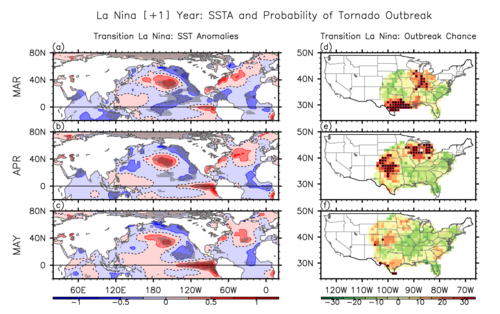
Curious on everyone else's thoughts?
Well, happy spring everyone! It being the start of traditional chase season I feel confident enough to lock in a forecast.
Forecast 20201 Tornado Season (MAMJ) :
Counts: Average (754 tornadoes across the CONUS during spring, 1250 plus or minus 50 for the year)
I feel fairly confident on average numbers for the chase season and year. With a moderate La Nina, but complicating factors such as drought, I think we see pretty normal activity. This activity should pick up fairly quickly here over the next two weeks with the first hints of the spring pattern shaping up. Some killers for this would be an early northward retreat of the jet (Aka Death Ridge) cutting into numbers early. This is a distinct possibility given the ongoing drought. A second, perhaps better for us failure mode would be a weak resurgent la nina. This could throw out some higher tornado numbers, though I think this is less likely. Its about 50/50 which side of the coin we end up on, which means I'm going to hedge to average.
Outbreak Days (10+ Tornadoes within 6 hours): Above Average
Its an emerging trend, fewer tornado days, but more tornadoes per day. Im sticking with that. You can define outbreaks in many ways so I'll have to run some stats to verify, but I think we see a more active outbreak pattern going into April and a few very big count days. The forecast is also calling for an above-normal hurricane year. I think we see another active TC tornado year this summer and fall.
Number of EF2+ tornadoes: Well Above Average (Greater than 1 STD above the normal mean)
Im taking a bit of a risk on this one but, with the southeast and eastern half (more populated) of tornado Alley looking more favorable, I'm leaning towards a much higher count of sig tors for the simple fact I expect more of them to hit things. The same trend will probably hold for fatalities.
Chasabillity Score: Average 6/10
My completely scientific and no non-sense chasing index, just kidding it's entirely arbitrary. Not a great year, not a bad year, somewhere right in the middle with a bit more chasing potential. We probably won't be chasing west of I-35 as much as we would like putting a dent into the chaseabillity of some systems, but the average counts combined with a few bigger days will get peoples chasing counts up. Midwestern gang and the southeast should have a decent year. Southern and central plains also won't have much to complain about. Perhaps not the best for the front range and Texas Panhandle guys and gals but a few days spark off. A banner year for a few, but sufficient for most.
We will see where we go from here. Good luck to everyone, stay safe and happy hunting!
A couple of points. Overall my yearly number prediction was pretty darn close. I predicted just below average on the annual inflation adjusted count and was darn close with the year end reports falling just 30 shy of my bottom end (1250 plus or minus 50). My big miss was the fact that April was very quiet and October and December ended up saving the average!

As for my spring count estimate (754), I fell a bit short with only 703 tornadoes being recorded between March and June. As mentioned, April was unusually slow this year with only 73 reported tornadoes. But again, not terrible with how things ended up.

Moving on to the outbreak Days, I'm still working on some verification metrics for this. It appears as though there were much fewer outbreak days but the few outbreaks we did have were sizeable. This is a known trend with tornadoes as of late and something I need to look at further. For now I'm going to assign a fail to this part of the forecast as I suggested things would be more active than they appeared to be. And several key outbreaks occurred well into the cool season outside of the time range I was really shooting for. I did make explicitly mention for the threat for several outbreaks associated with land falling TCs, this appears to have gone well with several big days happening across the Mid Atlantic.
Now to EF2+ tornadoes, Again, still working on some verification metrics for the counts of EF2+ but subjective interpretation says I did okay in this regard. The big outbreak days we did have produced quite a few sig tors. We also had the most fatalities since 2011 so that fits with the well above average forecast. I was expecting more during the spring when the December events ended up contributing to most of those. I need to work on some plots since the sig tor data isn't readily available.
Totally objective chaseability score wise I'm going to assign a hit to this for now. It seems like people who were able to get out did have an okay year. I do suspect however the objective metrics will be much lower across the plains when that data is run by Brett. The lack-luster April and only average May/June likely wont compensate for each other and I'm betting its a below average year. Subjectively there were some good tornado days as always. I did pretty poorly but most of that was beyond my control having to limit my chases. I did break my personal 4 year tornado drought in October in Southwest Oklahoma which feels good.
Now looking ahead, I'm seeing a fair amount of the same signals that we saw last year hinting that this year could again be a mixed bag. The big difference looks to be in the way ENSO is expected to evolve through the spring. While we did expect a weakening of la Nina last year, El Niño chances were much lower than this year with CPC calling for 60% chance of EL Nino development by summer/Fall this year. As I mentioned last year, positive TNI events (typical of Nina-Nino transitions) can result in active stretches particularly in the Midwest and southeastern US. Another big factor is the ongoing drought across the western US. How this impacts things is yet to be seen. I suspect the overall impact will be negative on the Plains at least through the early parts of the season. My current gut forecast is calling for an active year east of I-35 but the potential for lower counts in the Plains through spring again. I think things will heat up early season (Mar/April) again as la Nina continues to decay. (Western Gulf Coast southeast and Midwest) April in particular looks interesting. Positive TNI events can result in a significant uptick in probabilities for large outbreaks near and even west of I-35 in April. The GOM is quite warm and should remain so through the spring which is a positive sign for higher than average moisture flux and buoyancy. But, the signal for anything specific really drops off into May. If I had to guess, id expect a below average May this year with concerns about the ongoing drought the potential for El Niño to rapidly develop shifting ridging over the Plains. All in all though kind of a crapshoot this year. By March 1st we should have a much better idea of how things are shaping up. If you're planning a chase cation, I wouldn't stray from the traditional times as statistically its still your best bet. But, if you have the potential to chase earlier in the year pay attention in March and April in particular.

Curious on everyone else's thoughts?

